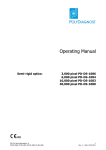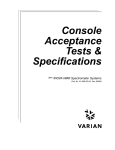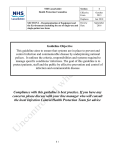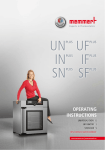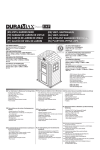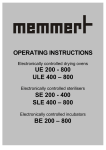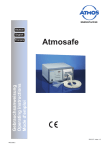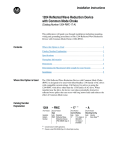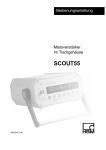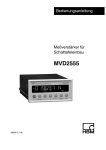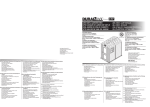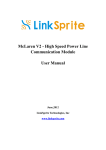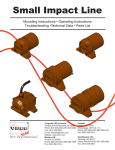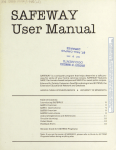Download AtmoCONTROL - Dickey John
Transcript
AtmoCONTROL
SOFTWARE MANUAL
100% ATMOSAFE. MADE IN GERMANY.
www.memmert.com | www.atmosafe.net
Manufacturer and customer service
Memmert GmbH + Co. KG
Willi-Memmert-Straße 90–96
D-91186 Büchenbach
Deutschland/Germany
Phone:
+49 (0)9122 925-0
Fax:
+49 (0)9122 14585
E-mail:
sales@memmert.com
Internet:
www.memmert.com
Customer service:
Service hotline:
+49 (0)9171 9792 911
Service fax:
+49 (0)9171 9792 979
E-mail:
service@memmert.com
© 2014 MEMMERT GmbH + Co. KG
09/2014
We reserve the right to make changes
AtmoCONTROL
About this manual
Purpose and target group
This user manual describes the installation and use of the MEMMERT programming software
AtmoCONTROL. It is intended for use by trained personnel of the operator, who have the task
of programming/operating MEMMERT appliances.
If you intend to work with the software, please read this manual carefully before starting. Familiarise yourself with the software and simulate various tests before transferring programmes
to the appliance. Incorrect use could result in damage to the appliance and/or to the chamber
load.
If there is something you do not understand, or certain information is missing, ask your superior or contact the manufacturer. Do not do anything without authorisation.
Other documents that have to be observed
Please also read the user manual for the respective appliance or appliances to be operated
with AtmoCONTROL and familiarise yourself with it.
Storage and resale
This manual should always be kept in a place where those working with the software have
access to it. It is the responsibility of the operator to ensure that persons who work with or
will work with the software are informed as to the whereabouts of this user manual. We recommend that it is always stored in a protected location close to the computer on which the
software is installed. Make sure that the manual is not damaged by heat or damp.
Update
The current version of AtmoCONTROL and this manual are available for download at
www.memmert.com/de/service/downloads/software/.
www.memmert.com/de/service/downloads/software/
D24042 | Date 09/2014
3
AtmoCONTROL
Contents
1.
Introduction
1.1
1.2
Description........................................................................................................................... 6
Supported MEMMERT appliances and parameters ............................................................ 6
2.1
2.2
System requirements ........................................................................................................... 7
Installing AtmoCONTROL .................................................................................................... 7
3.1
3.2
3.2.1
3.2.2
3.2.3
3.3
3.4
3.4.1
3.4.2
3.4.3
3.4.4
3.4.5
Starting AtmoCONTROL ...................................................................................................... 7
Programme interface........................................................................................................... 8
Menu bar........................................................................................................................... 9
Toolbar............................................................................................................................... 9
Status bar ........................................................................................................................ 10
Installing device licence via Ethernet (Single Display Devices) .......................................... 10
Adding and disconnecting devices ................................................................................... 10
Adding device connected via Ethernet ........................................................................... 10
Connecting device using USB storage ............................................................................ 11
Connecting a device using database file ........................................................................ 11
Log file............................................................................................................................. 12
Disconnecting devices ..................................................................................................... 12
4.1
4.1.1
4.1.2
4.1.3
4.1.4
4.2
4.3
4.3.1
4.3.2
4.3.3
4.3.4
4.3.5
4.4
4.4.1
4.4.2
4.4.3
4.4.4
Editor window ................................................................................................................... 13
Overview.......................................................................................................................... 13
Creating a programme ................................................................................................... 13
Setting parameters.......................................................................................................... 15
Available parameters....................................................................................................... 16
Simulating the programme sequence (preview)............................................................... 22
Saving, loading, transferring and running the programme ............................................. 22
Saving the programme ................................................................................................... 22
Loading a saved programme .......................................................................................... 22
Transferring programme via Ethernet............................................................................. 23
Transferring a programme via USB storage medium ..................................................... 23
Selecting and starting a programme on the appliance.................................................. 23
Programme examples........................................................................................................ 24
Programme example with clock timer............................................................................ 24
Programme example with door locking ......................................................................... 25
Programme example sterilisation ................................................................................... 26
Programme example loop .............................................................................................. 27
5.1
5.2
5.3
Importing protocol from network .................................................................................... 28
Importing protocol from USB data medium..................................................................... 28
Exporting protocol............................................................................................................. 29
2.
3.
4.
5.
4
Installation
Working with AtmoCONTROL
Programme
Protocol
6
7
7
13
28
D24042 | Date 09/2014
AtmoCONTROL
6.
7.
Printing
Options
7.1
7.2
7.2.1
7.2.2
7.3
7.4
Language ........................................................................................................................... 29
USER-ID .............................................................................................................................. 29
Description ...................................................................................................................... 29
Use................................................................................................................................... 30
Sending emails .................................................................................................................. 30
Backup folder..................................................................................................................... 31
8. Event codes of the log file Log.txt
Index
D24042 | Date 09/2014
29
29
32
34
5
AtmoCONTROL
1.
Introduction
1.1 Description
AtmoCONTROL is a software for programming and logging MEMMERT appliances of the
generation 2012 of appliances (from October 2012) with Ethernet and/or USB interface and
corresponding equipment.
With AtmoCONTROL, you can
► graphically create, modify and save programmes on your computer with various parameters and transfer these to the appliance (description from page 13);
► read out, organise and document the internal log memory of appliances (description from
page 28);
► configure user authorisations on USER ID USB sticks, with which the manual adjustment
of individual or all parameters on the appliance can be prevented (description from page
29).
1.2 Supported MEMMERT appliances and parameters
Using AtmoCONTROL, programmes can be created and transferred, protocols read out and
USER IDs configured for the following appliances of the generation 2012 of appliances (from
October 2012):
Appliance
Programmable main parameter
Temperature
Humidity
Pressure
CO2
O2
Fan speed
Air flap
Light*
UNPLUS
–
–
–
–
–
UFPLUS
–
–
–
–
INPLUS
–
–
–
–
–
IFPLUS
–
–
–
–
PLUS
SN
–
–
–
–
–
SFPLUS
–
–
–
–
HPP
–
–
–
–
–
PLUS
IPP
–
–
–
–
–
–
ICP
–
–
–
–
–
ICH
–
–
–
*
* additional option
For all other MEMMERT appliances of the generation 2012 of appliances, protocols can only
be read out using AtmoCONTROL via Ethernet (see page 28); parameters can only be set on
the appliance itself.
6
D24042 | Date 09/2014
AtmoCONTROL
2.
Installation
2.1 System requirements
Category
Minimum system requirements
Processor
Pentium 1 GHz
Main memory
1 GB
Available free space on
hard drive
4 GB
Graphics
VGA graphics and colour monitor
Interfaces
an available USB or Ethernet interface
Operating system
Windows 7, Windows 8
2.2 Installing AtmoCONTROL
You must have administrator rights to be able to install AtmoCONTROL.
Start the installation file AtmoControlSetup.exe from the USB storage medium provided. You
are now guided through the installation process step by step.
3.
Working with AtmoCONTROL
3.1 Starting AtmoCONTROL
AtmoCONTROL can be started in two ways:
► by double-clicking on the shortcut created on the desktop:
► in the Start menu (StartProgramsAtmoCONTROL)
D24042 | Date 09/2014
7
AtmoCONTROL
3.2 Programme interface
The main programme interface window of AtmoCONTROL is divided into the following areas:
2
1
6
5
3
4
1
2
3
4
5
6
Menu bar (see section 3.2.1)
Toolbar (quick access to most important functions, see section 3.2.2)
Status bar (provides an overview of available appliances, see page 10)
Show/hide status bar
Editor, simulation and protocol window (only for appliances listed on page 6,
otherwise only protocol window)
Programming mode switch (for editor/simulation/protocol, see pages 22 and 28)
(only for appliances listed on page 6)
You may change the language of the
programme interface at any time. German or English can be set („Options"
„Language”).
8
D24042 | Date 09/2014
AtmoCONTROL
3.2.1 Menu bar
Device
1
2
3
4
5
1
2
3
4
5
6
7
Program
Connect online via Ethernet
Connect offline from USB device
Connect offline from database
Disconnect device
Disconnect all devices
6
7
8
9
10
11
Protocol
New
12 Import...
Load
13 Export...
Save
Save As...
Upload to Device
Export to USB drive
Connect to device via
Ethernet (see page 10)
Connect device using
protocol data on USB
storage medium (see
page 11)
Connect device using
database file (see page
11)
Disconnect selected device (see page 12)
Disconnect all devices
Create new programme
(see page 13)
Load a saved programme
(see page 22)
8
9
10
11
12
13
14
Print
Options
14 Print
15
16
17
18
Help
Language
USER-ID
Email options
Edit Backup Folder
Save programme
Save programme under a
new name
Transfer programme to
device via Ethernet (see
page 23)
Export programme to
USB storage medium (see
page 23)
Import protocol from
USB storage medium (see
page 28)
Export protocol data (see
page 29)
Print (see page 29)
19 About...
20 User Manual
21 Upload license file to device
15 Change programme language (German/English)
16 Configure USER-ID (see
page 29)
17 Automatic sending of
emails (see page 30)
18 Edit backup folder (see
page 31)
19 Programme information
20 Open this manual in PDF
format
21 Install device licence (see
page 10
3.2.2 Toolbar
The toolbar provides rapid access to the most important menu functions:
1
2
1
2
3
D24042 | Date 09/2014
4
5
6
3
Create a new
programme
Load programme
from the data
medium
Save new
programme
4
5
6
Enlarge view
((zoom in)
Reduce view
(zoom out)
Show full
programme
9
AtmoCONTROL
3.2.3 Status bar
The status bar gives an overview of the appliances logged on to AtmoCONTROL. Appliances
can be added and removed again.
If the appliance is connected to the computer via Ethernet and it has already been logged
on once, it is automatically recognised and the current operating state (temperature,
alarms) is displayed (Fig. 1).
1
2
UF 260plus Laboratory
180.0°C
i
3
4
Fig. 1
An appliance of type UF 260PLUS (1), named "Laboratory" (2) by the user, is registered via Ethernet (3) in AtmoCONTROL; current temperature 180.0 °C (4)
3.3 Installing device licence via Ethernet (Single Display Devices)
1. Click on “Help”“Upload license file to device”.
2. In the window now opening, select the licence file (*.lic) and click “OK”.
3. Enter the IP address of the appliance you want to
transfer the licence to.
A description of how to set the IP address is
provided in the user manual of the corresponding appliance.
4. Click on “Upload” to start transferring the licence. The appliance can now be added (registered) in AtmoCONTROL as described in the following section.
3.4 Adding and disconnecting devices
3.4.1 Adding device connected via Ethernet
1. Click on „Device"„Connect online via Ethernet”.
2. In the window opening now, enter the IP address of the
device. Default setting is the standard IP address all devices have at delivery (192.168.100.100). The IP address
entered here must correspond to that of the device.
10
D24042 | Date 09/2014
AtmoCONTROL
A description of how to change the IP address of a device is provided in the user
manual of the corresponding device.
If you click on „Connect” now, the device is added to the status bar and you can create programmes for it or read out protocols.
3.4.2 Connecting device using USB storage
1. Export protocol data from an device to USB storage medium.
A description of how to read protocol data on a device is provided in the user
manual of the corresponding device.
2. Connect the USB storage medium to your computer/laptop.
3. Click on „Device"„Connect offline from USB device”. All devices for which protocol data
are saved on the USB storage medium are connected.
3.4.3 Connecting a device using database file
1. Click on „Device"„Connect offline from
database”.
2. A window opens, in which you can open the
device database file (*.atdb).
As soon as the appliance has
been added, you can have
detailed appliance information displayed at any time.
To do this, click on the
icon in the appliances view
("Device"). A window opens,
displaying detailed information. Here, you can also
enter a name of your choice
for your appliance later on,
if you have not already done
so when logging on, or
change the appliance name.
D24042 | Date 09/2014
11
AtmoCONTROL
3.4.4 Log file
If a device is added – no matter whether this is done using a USB stick or via Ethernet – the log
file Log.txt is also transferred and saved in a subfolder of the directory
C:\ProgramData\Memmert\AtmoControl\
The log file is structured as shown in the
A
B
C
D
example on the right:
A Date and time of events
B + Beginning of the event
– End of the event
C Alarm / event code
D Alarm / event description
A detailed list of all event codes is given
from page 32.
3.4.5 Disconnecting devices
If you want to remove a device from
the status bar, select it and then click on
„Device"„Disconnect device”. In order to
disconnect all connected appliances, use
„Disconnect all devices”.
12
D24042 | Date 09/2014
AtmoCONTROL
4.
Programme
4.1 Editor window
4.1.1 Overview
In the Editor window, programmes can be created: sequences of various parameters (e.g.
temperature, pressure and humidity), which the appliance then implements from a definable
point in time.
To be able to create a programme in AtmoCONTROL, the appliance which is to perform the
programme must be listed in the status bar and selected (clicked on). The appliance can, but
does not have to, be connected to the computer via the network. If the appliance is not yet
listed in the status bar, it must be added (see page 10).
4.1.2 Creating a programme
Select the appliance that will later perform the programme by clicking on it in the status
bar (Fig. 2, No. 1). An icon bar with the available parameters (functions) for this appliance is
shown (2, description from page 16). Additionally, one or two editor threads (3 and 4) are
displayed, depending on the appliance. The programme sequence is determined on these.
Two editor threads are always shown for appliances with humidity or pressure control,
and one editor thread for all others.
Bear in mind that the two editor threads are not synchronised. This means that a specific X
position on one thread does not match the same position on the other thread in time. If you
want to see the parameter values for a specific point in time, you must change to the simulation mode (see page 22).
If you want to create a time correlation to a specific point, use the "Sync" function (see page
20).
2
1
3
4
Fig. 2
Elements to create a programme
1 Appliance selected
2 Available parameters (functions)
3 Editor thread
4 Additional editor thread for appliances with humidity or pressure control
D24042 | Date 09/2014
13
AtmoCONTROL
To create a programme, drag the individual parameter icons onto the editor thread one after
another in the desired order, while holding down the left mouse button (Fig. 3 and Fig. 4). To
assist the correct positioning, a red insertion mark is displayed at the insertion position. With
the zoom icons in the toolbar list (see section 3.2.2 on page 9) or with the mouse wheel,
you can zoom in or out of the display or have the entire programme displayed.
Ramp 05
21.0 °C
Ramp 05
10
11 h:00
30 m
21.0 °C
180
180.0 °C
Increase
2 h:30 m
40.7 %rh
70.6 %rh
LIGHT
10
11 h:00
30 m
180
180.0 °C
0%
Fig. 4
Drag other parameters – light and a humidity
change in this case – onto the editor thread.
A red insertion mark helps you to find the
correct position.
The temperature icons (change/hold temperature) may only be placed on the upper editor
thread, humidity and pressure icons only on the lower one.
The meaning of the individual icons and the adjustment options are described from page
16. You can find some simple programme examples from page 24.
Fig. 3
Drag the parameter icon (in this case a temperature change) onto the editor thread while
holding the mouse button down
Removing a parameter icon from the editor thread
To remove a parameter
icon (and therefore its
function) from an editor thread – if you have
inserted it by mistake, for
example – select it and,
with the mouse button
depressed, move it to the
recycle bin symbol on the
lower right (Fig. 5).
Fig. 5
To delete a parameter icon from an editor thread, drag the icon,
with the mouse button depressed, to the recycle bin symbol.
14
D24042 | Date 09/2014
AtmoCONTROL
4.1.3 Setting parameters
If a parameter icon is selected (clicked) on an editor thread, it is
displayed with an orange frame. The adjustable values – in the
example on the right, the ramp name, the duration of the ramp
and the setpoint temperature – have a grey background.
To adjust values, click successively on the corresponding fields – in
the example on the right, the setpoint temperature. The value is
highlighted in colour and can be changed by keyboard entry or
clicking on the arrow icons.
The adjustment range depends on the appliance for which the
programme is created.
The main parameters have additional adjustment options, which
can be displayed by clicking on the fold down icon (Fig. 6, No. 1).
Here, the adjustable values – in the example below, the tolerance
band and the setpoint dependency (SPWT) – also have a grey
background (2) and can be adjusted after being clicked on (3).
- - h:- - m
21.0 °C
- - - .- °C
Ramp 01
1 1 h:3 0m
21.0 °C
37.0 °C
2
Tolerance band
Tolerance band
3
1
0,1 K/min
0,1 K/min
Fig. 6
Further adjustment options fold down after clicking on the arrow icon on the right
edge of the window (1)
D24042 | Date 09/2014
15
AtmoCONTROL
4.1.4 Available parameters
Below, all the parameter icons with their adjustment options are shown.
Which parameters are available to adjust the programme depends on the appliance for
which a programme is to be created. Only those parameters are available that the appliance is able to implement. For appliances without humidity regulation, for example, no
humidity icon is available. The respective adjustment options (temperature ranges etc.) are
appliance-specific.
Broad parameter representation
Depiction Meaning
in icon bar
Depiction on
editor thread
Function and
adjustment options
Function
Maintains a set temperature for a
specific time.
Tolerance band
Hold temperature
?
Adjustment options
•
•
•
•
•
•
Name of programme segment1
Duration (time or infinite ∞)
Temperature to be maintained
Tolerance value above/below
Alarm if limits are exceeded
Safe2
(For programme example, see page
24)
Function
Tolerance band
Change
temperature
?
0,1 K/min
Increases or decreases temperature
over a specific time to a set value.
Adjustment options
•
•
•
•
•
Name of programme segment1
Duration
Target (setpoint) temperature
Tolerance value above/below
SPWT3
(For programme example, see page
25)
When run, this is displayed in the status bar of the appliance
When Safe is "on", it is ensured that the value really is maintained within the tolerance band as long as
specified, and only then is the programme continued (this is sensible for sterilisers, for example). If the
actual values leaves the tolerance band, the clock timer starts again from the beginning.
3
SPWT: Setpoint wait. If this is "on", the programme sequence is not continued before the setpoint
value is reached, even if the set time has already expired. If this is "off", the programme sequence is
continued after the set time has expired, irrespective of whether the setpoint value was reached or not.
1
2
16
D24042 | Date 09/2014
AtmoCONTROL
Depiction Meaning
in icon bar
Depiction on
editor thread
Function and
adjustment options
Function
Maintains a specific humidity for a
specific time.
12 h:00 m
Hold
Hold
humidity
?
Tolerance band
+ 0.0 %rh
- 5.0 %rh
on
off
Alarm
70.0 %rh
Safe
Adjustment options
• Name of programme segment1
• Duration (time or infinite ∞)
• Humidity value to be maintained
• Tolerance value above/below
• Alarm if limits are exceeded
• Safe2
Function
Increase
Change
humidity
2 h:30 m
Tolerance band
+ 5.0 %rh
- 5.0 %rh
?
on
40.7 %rh
70.6 %rh
SPWT
off
Increases or decreases humidity
over a specific time to a specific
value.
Adjustment options
• Name of programme segment1
• Duration
• Target (setpoint) humidity
• Tolerance value above/below
• SPWT3
When run, this is displayed in the status bar of the appliance
When Safe is "on", it is ensured that the value really is maintained within the tolerance band as long as
specified, and only then is the programme continued (this is sensible for sterilisers, for example). If the
actual values leaves the tolerance band, the clock timer starts again from the beginning.
3
SPWT: Setpoint wait. If this is "on", the programme sequence is not continued before the setpoint
value is reached, even if the set time has already expired. If this is "off", the programme sequence is
continued after the set time has expired, irrespective of whether the setpoint value was reached or not.
1
2
D24042 | Date 09/2014
17
AtmoCONTROL
Depiction Meaning
in icon bar
Depiction on
editor thread
Function and
adjustment options
Function
hold p
Hold pressure
2 h:30 m
Tolerance band
+ 20 mb
- 10 mb
?
on
off
Alarm
500 mb
decrease
2 h:30 m
Safe
Tolerance band
+ 20 mb
- 10 mb
Change
?
pressure
on
1100 mb
500 mb
SPWT
off
Maintains a specific pressure for a
specific time.
Adjustment options
• Name of programme segment1
• Duration (time or infinite ∞)
• Pressure to be maintained
• Tolerance value above/below
• Alarm if limits are exceeded
• Safe2
Function
Increases or decreases pressure
over a specific time to a specific
value.
Adjustment options
15
• Name of programme segment1
• Duration
• Target (setpoint) pressure
• Tolerance value above/below
• SPWT3
When run, this is displayed in the status bar of the appliance
When Safe is "on", it is ensured that the value really is maintained within the tolerance band as long as
specified, and only then is the programme continued (this is sensible for sterilisers, for example). If the
actual values leaves the tolerance band, the clock timer starts again from the beginning.
3
SPWT: Setpoint wait. If this is "on", the programme sequence is not continued before the setpoint
value is reached, even if the set time has already expired. If this is "off", the programme sequence is
continued after the set time has expired, irrespective of whether the setpoint value was reached or not.
1
2
18
D24042 | Date 09/2014
15
AtmoCONTROL
Narrow parameter representation
With the narrow parameter representation, no time progression can be set, in contrast to
broad parameter representation. The setting made immediately becomes active at the respective position – and remains active until it is changed by the insertion of a new parameter icon
of the same type.
Depiction Meaning
in icon bar
Depiction on
editor thread
CO 2
50%
? 2
CO
15 0
Adjustment options/
comments
0 to 20 percent
For a setpoint ≠ 0.0, the fan is automati15
cally set to 50 %.
STAND BY
O
22
CO
?
O2
1 to 20 percent, off
STAND BY
15
12.0 %
FAN
?
0 to 100 percent in steps of 10 %
(For programme example,
15 see page 26)
STAND BY
Fan speed
100 %
FLAP
?
Air flap
position
0 % (closed, recirculating operation) to 100 %
(opened completely, fresh air operation) in
15
steps of 10%
(For programme example, see page 26)
STAND BY
100 %
LIGHT
Interior
lighting
depends on appliance type
• 0 or 10015% (off/on)
• 0 to 100 % in steps of 1%
STAND BY
100 %
UV LIGHT
UV light
on
HORN
Horn
D24042 | Date 09/2014
STAND BY
on/off 15
off
Adjustment options: none
Appliance emits an acoustic signal at the
position
in the programme at which the icon
15
was inserted, for example if a specific setpoint
value is reached or the programme is finished.
STAND BY
19
AtmoCONTROL
Depiction Meaning
in icon bar
Depiction on
editor thread
Adjustment options: open/close
Close/open door at the position in the programme at which the icon was inserted.
(For programme example, see page 25)
DOOR
Door
Adjustment options/
comments
STAND BY
15
close open
SWITCH
Switch
STAND BY
15
A
close open
Switches a switching contact (A, B or C) on or
off at the insertion position
DEFROST
Activates the defrosting function of the appliance at the insertion position
STAND BY
Defrost
15
CLOCK TIMER
Mo Tu
We Th
Fr
Sa Su
STAND BY
15 Clock timer
11 h:30 m
CALENDAR
15
STAND BY
Calendar
Day
18
Month
05
Year
2012
- -h:-30-mm
22
Here, the day(s) and the time at which the programme is to be performed, can be adjusted.
The programme is repeated each week at the
specified times.
(For programme example, see page 24)
Here, the date and time at which the programme is to be performed, can be adjusted.
In contrast to the clock timer, the programme
is run only once.
SYNC
• Setting "and": The programme is only
15
continued when the preceding ramps are
finished on both editor threads.
• Setting "or": The programme is continued
as soon as one of the preceding ramps is
finished.
Synchronising
STAND BY
and
20
or
D24042 | Date 09/2014
5
AtmoCONTROL
Depiction Meaning
in icon bar
Depiction on
editor thread
JUMP
TARGET
STAND BY
15
LOOP
Loop
4X
Adjustment options/
comments
The programme jumps back from the insertion
position to a position that can be freely selected and repeats the sequence between n times
(adjustable). When inserting a loop function,
an icon for the jump target is automatically
inserted at the programme start. Holding the
mouse key down, move it to the beginning of
the range that is to be repeated.
Loops may be embedded inside one another:
JUMP
TARGET
... ...
JUMP
TARGET
LOOP
4X
LOOP
2X
(For programme example, see page 27)
STANDBY
STAND BY
Standby
D24042 | Date 09/2014
Switches all appliance functions off at the
insertion position
21
AtmoCONTROL
4.2 Simulating the programme sequence (preview)
While creating the programme, you can display the prospective progression of all parameters
as a diagram at any time. To do this, click on "Simulation" (Fig. 7).
Depending on the complexity of the programme, it may take a few seconds for the simulation to be calculated and displayed.
Fig. 7
Programme preview diagram (simulation)
In simulation mode, no changes can be made to the programme, as this mode is just for
information purposes. Change to the editor window by clicking on the "Editor" button if
you want to alter the programme.
4.3 Saving, loading, transferring and running the programme
4.3.1 Saving the programme
Click on „Program”„Save as...”, enter a name for the programme and click on „Save".
The name with which you save the programme is later
displayed in the programme selection display on the
appliance.
4.3.2 Loading a saved programme
Via „Program"„Load”, you can reopen and continue editing the saved programmes.
22
D24042 | Date 09/2014
AtmoCONTROL
4.3.3 Transferring programme via Ethernet
To be able to transfer a programme via Ethernet, the appliance and computer must be
connected via Ethernet, the correct IP address set (see page 10) and the appliance
switched on.
Click „Program"„Upload to device”. The programme is uploaded to the appliance and can
be started there.
4.3.4 Transferring a programme via USB storage medium
1. Click „Program"„Export to USB drive”. The programme is saved on the USB storage
medium connected.
2. Connect the USB data medium to the appliance which is to run the program.
4.3.5 Selecting and starting a programme on the appliance
If the programme was transferred to the appliance via Ethernet or USB data medium, it can be
selected and started there.
How programmes are selected and started on the appliance is described in the user
manual for the appliance.
If the appliance is connected to the computer via the network, the respective current operating status can be monitored in the status bar of AtmoCONTROL (see page 10).
With appliances that have humidity control, make sure that the water supply tank of the
appliance is filled before the programme start. Check the level of the tank at regular intervals, especially for programmes that run for long periods. The same applies for appliances
with gas supply.
D24042 | Date 09/2014
23
AtmoCONTROL
4.4 Programme examples
For reasons of space, it is not possible to present programme examples with all the available parameters for all MEMMERT appliances here. Instead, a number of simple example
programmes will be presented to familiarise you with how a programme is structured.
Caution:
It is important that you run through a number of programme examples to get to know AtmoCONTROL before you actually transfer and run programmes on the appliance.
4.4.1 Programme example with clock timer
1
2
4
5
8
3
6
7
4
120 °C
3
7
50 °C
20 °C
8
Mo.
Tu.
We.
Th.
Fr.
Sa.
Su.
1
Fig. 8
The appliance heats up from Monday to Friday (1) at 8 am (2) to 120 °C (3) and continues to
maintain this temperature (infinitely ∞)) (4) until it is changed: also Monday to Friday (5) at 6
pm (6) to 50 °C (7) – again continued (infinitely ∞)) (8) until it is changed again in the morning
at 8 am (2).
24
D24042 | Date 09/2014
AtmoCONTROL
4.4.2 Programme example with door locking
3
4
Tolerance band
1,7 K/min
1
2
1
6
6
3
95 °C
45 °C
7 8
5
5
2
20 °C
12:00 h
≥ 0:30 h
Fig. 9
The door is locked at the beginning of the programme (1). Then, the appliance heats up to
95.0 °C
C (2) and maintains this temperature for 12 hours (3). Subsequently, the temperature is
lowered (5) for 30 minutes (4) to 45.0 °C
C and then, the door is opened (6). The setting "SPWT
on" (8) ensures that the door is opened only when the temperature really has dropped to
45.0 °C,
C, even if this takes longer than 30 minutes. Below the temperature change is shown in
K/min (7).
D24042 | Date 09/2014
25
AtmoCONTROL
4.4.3 Programme example sterilisation
4
6
Tolerance band
1
0%
2
3
1
100 %
100 % 0 %
6
180 °C
5
0%
2
4
7
3
20 °C
3:00 h
Fig. 10
At the beginning, the fan is switched on to 100 % (1) and the air flap is closed (0 %) (2). Then,
the appliance heats up to 180.0 °C
C (3) and maintains this temperature for 3 hours (4). The setting „Safe“ (5) ensures that the sterilisation time does not start (6) before the set tolerance band
(7) is reached and is restarted if it is exceeded.
26
D24042 | Date 09/2014
AtmoCONTROL
4.4.4 Programme example loop
1
4
Unload
7
2
3
3
5
6
8
9
6
0% 80% 0% 80% 0% 80% 0% 80% 0% 80% 0% 80% 0% 80% 0% 80% 0% 80% 0% 80% 0% 80% 0%
250 °C
2
5
1h
1h
1
4
20 °C
1h
1h
1h 1h
1h 1h 1h
1h 1h
1h
1h 1h
1h 1h 1h 1h 1h
1h
1h
1h
8
Fig. 11
First, the appliance heats up to 250.0 °C (2) for one hour (1). Then, the fan begins to run at 80
% power (3) and the temperature is lowered for one hour (4) to 20.0 °C (5). Subsequently, the
fan is switched off (6). This sequence is repeated from the jump target (7) ten times (8).
D24042 | Date 09/2014
27
AtmoCONTROL
5.
Protocol
5.1 Importing protocol from network
To be able to import a protocol via network, the appliance and computer must be connected to the network, the correct IP address set (see page 10) and the appliance
switched on and logged in to AtmoCONTROL.
Click on the "Protocol" button (Fig. 12); the protocol data of the appliance are transferred
and displayed and can be further processed – e.g. exported to a spreadsheet file format
(see Section 5.3).
Fig. 12
Protocol display (example)
5.2 Importing protocol from USB data medium
At the appliance, protocols can be exported to an USB storage medium and imported in
AtmoCONTROL:
How protocols on the appliance are exported to USB storage media is described in
the user manual for the appliance.
1. Connect the USB storage medium with the exported protocols to your computer/laptop.
2. Click on „Protocol"„Import”. The protocol data are transferred and displayed in AtmoCONTROL.
Protocol data are also loaded automatically if you connect an appliance using the protocol
files on an USB storage medium (see page 11).
28
D24042 | Date 09/2014
AtmoCONTROL
5.3 Exporting protocol
With „Protocol"„Export”, you can export a freely
definable protocol logging period into a file of the
types *.csv or *.xlsx (Excel), which can be processed in
spreadsheet programmes (Fig. 13).
6.
Printing
With the „Print" function, you can print out programmes in the editor window, as well as simulations and protocols – depending on what is currently
displayed.
7.
Options
7.1 Language
You can set the language of the user
interface (German or English) under
“Options””Language”.
Fig. 13
Exporting protocols
7.2 USER-ID
7.2.1 Description
With the appliances listed in the table on page 6, it
is possible, with the help of an encrypted "USER-ID" file
on a special USB stick (Fig. 14), to lock functions of the
User-ID
appliance or to restrict them in their operation. You can
configure which parameters are to be prevented from
being adjusted when the USER-ID USB stick is removed.
AtmoCONTROL cannot generate a USER-ID file,
Fig. 14
but only change the authorisations of a purchased
USER-ID USB stick
USER-ID file on a USER-ID data medium. If there is
no valid USER-ID file on the USB data medium, configuration in AtmoCONTROL is also not possible.
There can be only one USER-ID on a USER-ID USB stick. The settings in this file then apply for
all appliances configured.
A USER-ID identifier on a USER-ID USB stick for one (or several) serial numbers can be purchased. This data medium contains a file with keys for one or more appliances. With the help
of AtmoCONTROL, the function of the USER-ID key can be changed.
D24042 | Date 09/2014
29
AtmoCONTROL
7.2.2 Use
1. Insert the USER-ID USB stick with the USER-ID file into the
computer with AtmoCONTROL.
2. In the Options menu bar, click on USER-ID.
3. A window appears with the functions of the logged on appliance
that can be blocked (depending on the appliance type).
4. Click on the lock icon next to the functions that should be blocked
or released, and confirm this with OK.
5. Eject and remove the USER-ID USB stick, insert it in the appliance
and activate.
How USER-IDs are activated and deactivated on the appliance is described in the operating instructions for the appliance.
7.3 Sending emails
AtmoCONTROL can automatically send an email to a freely definable recipient if an alarm
was triggered, e.g. if the temperature is exceeded. To make the corresponding settings, select
„Options"„Email options” (Fig. 15). Your computer/laptop must have internet access and you
need to have an e-mail provider or outgoing mail server. The login data (user name, password
etc) are entered like in an email programme.
Fig. 15
Settings for the automatic sending of emails in case of alarm
events
30
D24042 | Date 09/2014
AtmoCONTROL
7.4 Backup folder
You can set up a backup folder in which
AtmoCONTROL saves backup copies of
programmes and user data. To do so,
click on “Options””Edit Backup
Folder”.
You can either use the default folder or
select a different one.
D24042 | Date 09/2014
31
AtmoCONTROL
8.
Event codes of the log file Log.txt
(see page 12)
Error codes for Generation 2012 appliances
Status: October 09, 2012
In case of a hardware error of the oven, the controller displays the following error codes in a status /
error window, as well as logs them in the “Log.txt” file in the “Config” directory on the SD card.
The position of the error number further specifies the position of the error.
Error code
101: OS Error
102: File System Error
103: USB Error
104: GUI Error
105: IP Stack Error
106: I2C Bus Error
107: RTC Error
108: RAM Disk Error
109: WatchDog Reset
110: Power Supply OK
111: Controller Restart
201: Config Error
202: Calib User Error
203: Calib System Error
204: PID Config Error
205: User Config Error
206: Battery Error
207: SD Card Space
208: SD Card Full
209: SD Card Missing
210: Failed To Copy Protocol
211: Restauration Failed
212: Max Count Of Profiles
301: Fan Error
302: Heating Error
303: Temp Limitor
304: Door open
305: Hzg Err
Parameter
200000
020000
Note:
The position of the red digit
indicates the defective stage
of the appliance.
002000
000200
000020
000002
100000
010000
001000
000100
32
Description
Operating system error
File system error
USB error
Graphical user interface error
Ethernet error
12C bus error
Realtime clock error
RAM disk error
Watchdog error
Power Supply OK
Restart after reset
Configuration error
Error in calibration file (user)
Error in calibration file (calibration system)
Error in PID parameters
Error in user settings
Battery low
Warning at 95% disk space usage
Error, SD card is full
SD card is missing
Error copying the protocol
Error restoring LastState
Maximum number of profiles on SD card reached
Fan speed error
Heating error
Temperature limiter has triggered
Door is opened
Triac optocoupler heating 1 power module 1
defective
Triac optocoupler heating 2 power module 1
defective
Triac optocoupler heating 1 power module 2
defective
Triac optocoupler heating 2 power module 2
defective
Triac optocoupler heating 1 power module 3
defective
Triac optocoupler heating 2 power module 3
defective
Triac heating 1 power module 1 defective
Triac heating 2 power module 1 defective
Triac heating 1 power module 2 defective
Triac heating 2 power module 2 defective
D24042 | Date 09/2014
AtmoCONTROL
306: Comm Err
401: Humidity Sensor
402: Humidity Min Al
403: Humidity Max Al
404: Water tank empty
405: Temp Sensor Defunct
406: Sensor Alarm
407: Temp Min Alarm
408: Temp Max Alarm
409: Temp Auto Alarm
410: Lights Off
501: Sensor CO2 Error
502: CO2 Empty
503: CO2 Auto Switch
504: CO2 Min Alarm
505: CO2 Max Alarm
506: Sensor O2 Error
507: N2 Empty
508: O2 Min Alarm
509: O2 Max Alarm
601: Vacuum Sensor Error
602: No Shelf
603: Vacuum Min Alarm
604: Vacuum Max Alarm
700: Power Min Border
701: Device Fail time
702: Device Start Time
801: Program Start
802: Program Cancelled
803: Program End
804: Invalid Program
D24042 | Date 09/2014
000010
000001
1000
0100
0010
0001
Triac heating 1 power module 3 defective
Triac heating 2 power module 3 defective
Power module 1 is not responding
Power module 2 is not responding
Power module 3 is not responding
Humidity power module is not responding
Humidity sensor defective
Humidity below minimum value
Humidity maximum value exceeded
Water tank empty
Temperature sensor defective
Monitoring sensor defective
Temperature below minimum value
Temperature maximum value exceeded
Temperature tolerance band violated
Automatic lights switch-off
CO2 sensor defective
CO2 supply interrupted / gas cylinder empty
Notification of gas cylinder change
CO2 below alarm limit
CO2 alarm limit exceeded
O2 sensor defective
N2 supply interrupted / gas cylinder empty
O2 below alarm limit
O2 alarm limit exceeded
Pressure sensor defective
No shelf inserted
Pressure below alarm limit
Pressure alarm limit exceeded
Voltage below minimum limit
time of power failure
time of restart
Programme start
Programme cancellation
Programme end
Programme cannot be loaded
33
AtmoCONTROL
Index
.atdb 11
A
Air flap position 19
Appliance information 11
Appliance name 11
B
Backup folder 31
C
Calendar 20
Change humidity 17
Change temperature 16
Clock timer 20, 24
Closing door 20
CO2 19
Creating a programme 13
Customer service 2
D
Database file 11
Defrost 20
Device licence 10
Disconnecting a device 12
Door locking 25
E
Editor threads 13
Editor window 13
email 30
Enlarge view 9
Ethernet interface 6
Exporting protocol 29
F
Fan speed 19
Fold down icon 15
Forwarding 3
G
Generation 2012 of appliances 6
H
Hard drive storage space 7
Hold humidity 17
Hold pressure 18
Hold temperature 16
Horn 19
34
I
R
Importing protocol from
network 28
Insertion mark 14
Installation 7
Interior lighting 19
IP address 10, 28
Issue information 20
Removing parameter icon
14
L
Language 8, 29
Licence 10
Loading a saved programme
22
Lock icon 30
Loop 21, 27
M
Main memory 7
Main programme window 8
Manufacturer 2
Menu bar 9
O
O2 19
Opening door 20
Operating state 23
Operating system 7
Options 29
P
Parameter representation
16, 19
Parameters 16
Preview 22
Printing 29
Processor 7
Programmable parameters 6
Programme 13
Programme example loop
27
Programme examples 24
Programme example sterilisation 26
Programme example with
clock timer 24
Programme example with
door locking 25
Programme interface 8
Programme selection display
22
Protocol 28
S
Safe 16
Saving a programme 22
Selecting programme on appliance 23
Sending emails 30
Setpoint dependency 15
Setpoint wait 16
Setting parameters 15
Show full programme 9
Simulating programme
sequence 22
Simulation 22
SPWT 15, 16, 25
Standby 21
Starting a programme 23
Starting AtmoCONTROL 7
Start menu 7
Status bar 10
Status display 16
Sterilisation 26
Storage 3
Supported appliances 6
Switching switch contacts
20
Synchronising 13, 20
System requirements 7
T
Target group 3
Tolerance band 15
Toolbar 9
U
USB data medium 23, 29
USER-ID 29
USER-ID USB stick 29
UV light 19
W
Water supply tank 23
Z
Zooming 9
D24042 | Date 09/2014
AtmoCONTROL
D24042 | Date 09/2014
englisch
Memmert GmbH + Co. KG
Willi-Memmert-Straße 90-96 | D-91186 Büchenbach
Tel. +49 9122 925-0 | Fax +49 9122 14585
E-Mail: sales@memmert.com
facebook.com/memmert.family
Die Experten-Plattform: www.atmosafe.net





































